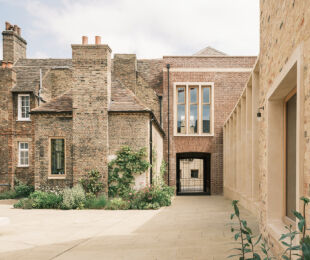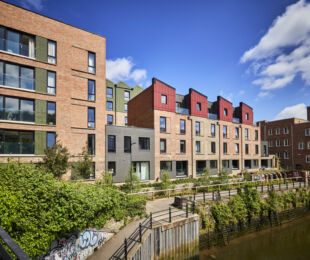
A sensitive addition to Hampstead Conservation Area in north London, Fleet House is a contemporary dwelling by architect Stanton Williams that reinterprets the historic tradition of boundary walls in Hampstead Village. The design originates from the idea of re-establishing lost boundaries that once defined the site, at the junction between Admiral’s Walk and a neglected historic footpath. Fleet House replaces a nondescript house, taking the opportunity to reestablish the alignment with the pavement, not least to be continuous with the tall garden wall of the adjacent grade-one-listed Fenton House.
“We were particularly interested in reinstating the local tradition and developing the house around the idea of an almost endless boundary – one that at the same time shelters and generates the domestic space”, says Patrick Richard, principal director at Stanton Williams. “Acting as a textured, protective shell, the boundary unfolds into a series of habitable spaces, gains thickness, hides and creates entrances, rooms and courtyards as it responds to its context. The boundary wall becomes the house.”
The approach seemingly ‘excavates’ the domestic space from the boundary, like a carved volume from which elements are extruded and extracted by the addition and subtraction of blocks. A change of texture and colour – from a coarse dark brick outer shell to smooth white stucco interiors – reinforces this sculptural idea.
Fleet House’s external palette has been selected with regard to the Georgian context, which includes large mansion houses, terrace houses and many walled gardens. These define the character of Hampstead village and provide a distinctive reference point for the design and materiality, consistent with Stanton Williams’ interest in natural materials that are tactile, age well and are low maintenance. The use of brick was a logical, contextual choice, although the final specification and appearance was considered in dialogue with the planners. The 40mm high bricks were laid with flush lime mortar joints to accentuate the monolithic qualities of the carved brick volumes and to minimise movement joints. Two brick colours are used in equal proportions in a random layout. In some locations, areas of raked horizontal joints are used to enhance the geometry and character of the facades.
Stanton Williams also designed the interiors and bespoke pieces of furniture. Natural light and breathing space are key elements of the spatial experience, as are the physical qualities. Continuous surfaces in handmade brick, Gneiss stone, stucco and European oak spread from exterior to interior – to offer ‘a sense of serene infinity’. Long perspectives and vestibules connect domestic moments – with light always guiding the journey, relating inside with outside. “Our aim was to create contemporary but timeless architecture, rooted in its context without pastiche. We wanted to relate the house to the strong architectural elements of the neighbourhood, while keeping the building identifiable within its own era and its own narrative charge,” says Richard.
The 388-square-metre house features an open-plan living space, four bedrooms, three bathrooms, study, gym, garage, ceramics studio and a Japanese-inspired garden. It is heated by a ground-source heat pump supplemented with solar water heating that stores excess summer heat deep below ground. The design also features whole-house ventilation with heat recovery, and a rainwater harvesting system for toilet flushing. The predicted carbon emissions are 40 per cent lower than the Building Regulations maximum and the house has achieved compliance with the Code for Sustainable Homes Level 4 standard.






